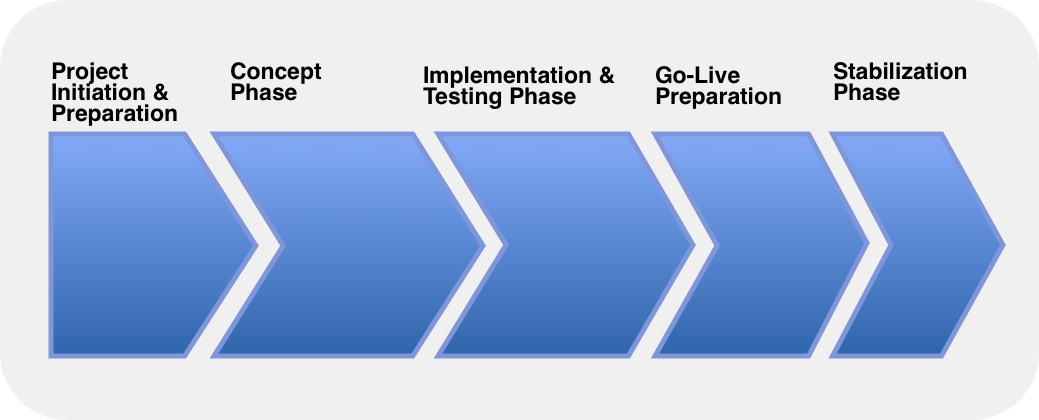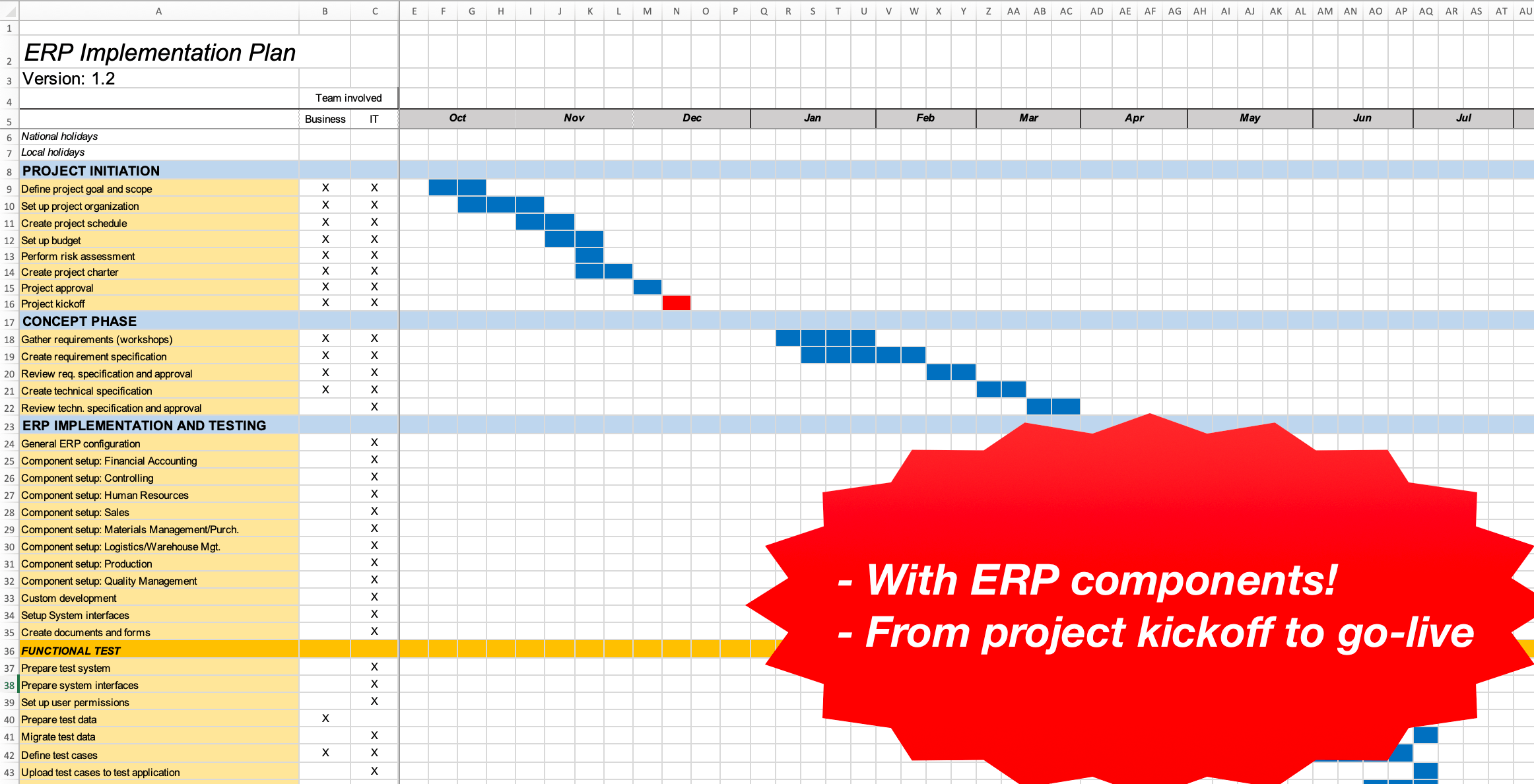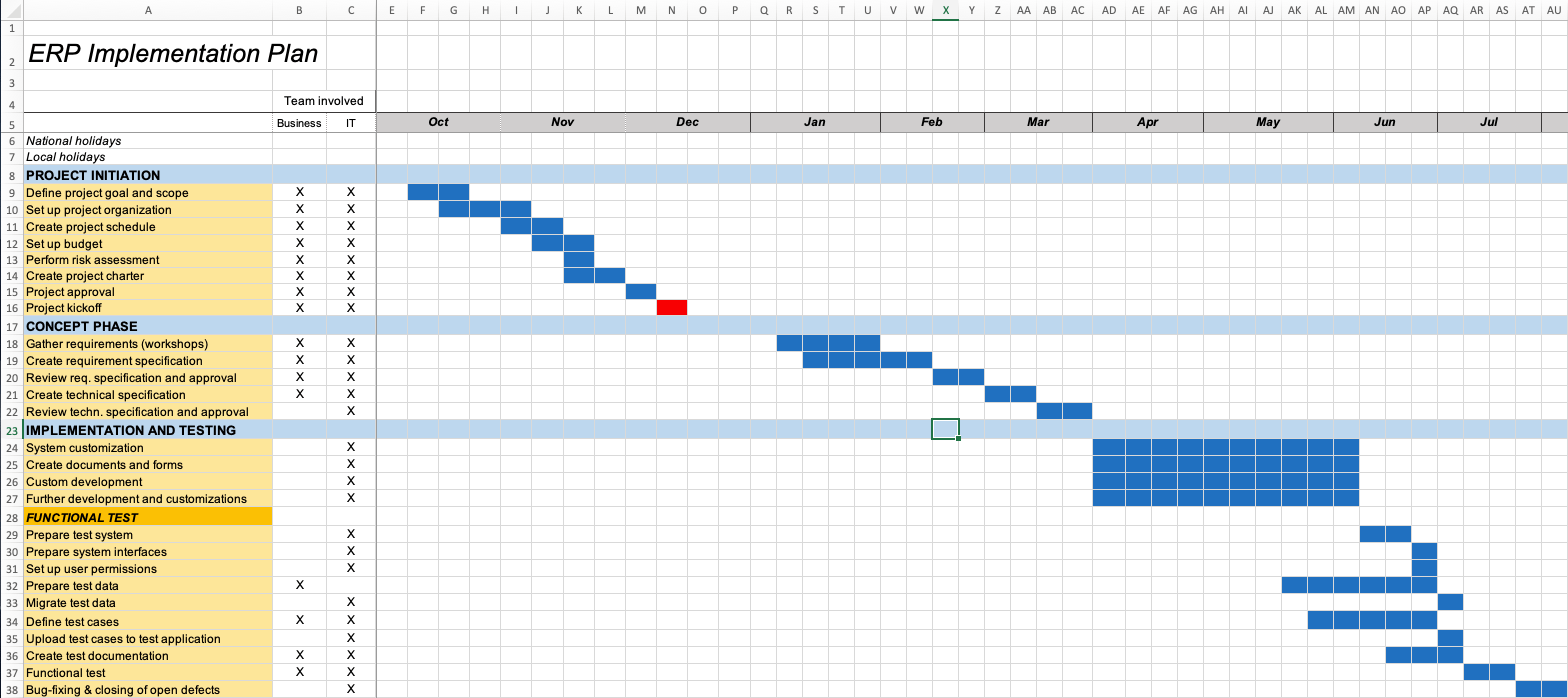Over the past years I have led several large ERP implementations with success (read about my story and projects here). We followed a plan which is more or less the same in all ERP implementations.
In this article I’m giving you an overview of the project plan we followed for our own ERP rollouts. You can download the plan in Excel format here.
Managing a Dynamics 365 BC Rollout?
Are you looking for a Microsoft Dynamics 365 rollout plan? I have just published one here.
Managing an Oracle Fusion ERP Implementation?
Check out my playbook for Oracle Cloud ERP implementations:
How the implementation plan is structured
The implementation plan follows a phased (or waterfall) approach. This is the standard approach for ERP implementations, which usually have a fixed scope and specific schedule and budget constraints.
The project plan is structured into the following phases:
- Project initiation
- Concept phase
- Implementation and testing
- Go-Live preparation
- Stabilization

Let’s look at each phase one by one:
Phase #1: Project initiation
You usually start an ERP project with an initiation phase. This is where you set up the project, define the scope, put together a team, create the schedule and budget. The project approach is then documented in a project charter (a template is included in my Template Pack).
The key activities you need to take care of are listed in the implementation plan. Identifying the right team members is probably the most important step. With a good team of smart and reliable people who are enthusiastic about the project, you will even manage challenging phases.
Remember that any ERP implementation is first and foremost a business-driven project. It’s not a pure IT project! You are changing the way business processes are handled. Therefore you need to have people with a solid understanding of the business processes on the team.
Phase #2: Concept phase
The concept phase can last from a few weeks to several months. It depends on the size of your organization and on the project scope. Do you just want to role out core modules (such as Finance and HR) or do you want to implement an entire ERP suite with all modules? This decision has to be made during the initial scoping.
Phase #3: Implementation and testing
In this phase, your implementation partner will customize the system for your needs. While this is mainly technical work, the business still needs to be involved in order to answer any questions from the consultants and to define the details of how the system should work.
Once the technical preparations have been completed, you start with the first test. This is usually a functional test — also called user acceptance test (or UAT). For the test, the team has to prepare appropriate test cases. Test cases can be created easily using Microsoft Excel – check out my test plan template.
Further down the line, you will also have to carry out at least one integration test. Purpose of the integration test is to see if all ERP system modules operate successfully with each other. This is the prerequisite for running your business processes smoothly from start to finish in your ERP system.
Phase #4: Go-Live Preparation
If all tests have been successful, you can start preparing for go-live. This actually starts very early on with data cleansing activities.
If you are migrating from an old system, you have to inspect and clean up master data and transactional data. From all the ERP projects I have managed, I can tell you this is a huge effort which is usually underestimated.
In some projects we had to hire external contractors to help us clean up our data, just because the volume was too high. And you can’t really automate cleansing of data, because still a human being needs to look at the data records and decide which data records to keep and which ones can be deleted. What you can do however is to use an address validation service if you are reviewing customer or vendor master data.
As you are moving closer to the planned go-live date you need to start setting up the production system, including any required system interfaces.
The ERP implementation plan contains all the key steps you need to take. Training of end-users, informing the involved departments and stakeholders about the upcoming system change and of course carrying out the data migration onto your production client.
The final preparations and steps prior to the go-live are also summarized as cutover activities. You should create a separate and detailed cut-over plan for the go-live preparation and release of the new ERP system. The cut-over plan typically covers the final days and hours up to and including the go-live.
Phase #5: Stabilization
In your ERP rollout plan, you should also include a stabilization phase. These are the days and weeks following the go-live where the IT teams are on high alert to respond quickly in case of issues.p
Get the ERP Implementation Project Plan - a real-life project plan used in dozens of successful ERP implementations
- Covers the entire cycle from initiation to go-live
- With ERP component buildup (modules)
- Includes testing activities (functional, integration test)
- Timescale: weeks
- 30-day money back guarantee if you are not happy
Ask your question here!
Author
-
Hi! I’m Adrian, founder of Tactical Project Manager and a Project Manager with over ten years of experience. Managed large-scale IT implementations and business projects. I started Tactical Project Manager to offer you a straightforward and pragmatic approach to project management, enabling you to lead any project with confidence.
View all posts





